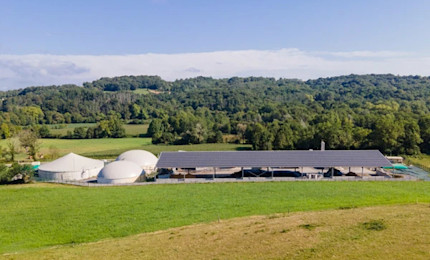Urgence gaz 0 800 028 800

Solidia Biogaz: Teréga commits itself to the development of renewable gases
Opened in March 2023, the Solidia biogas platform is currently the only facility that allows semi-industrial scale testing of innovative methanation and biogas recovery processes. This ambitious project, which prefigures the ways in which energy will be produced in the future, is owned by Teréga, INSA Toulouse and Cler Verts, with the support of the Occitanie region. A guided tour with Justine Morlas, Solidia project leader at Teréga, Guilhem Caumette, Environmental and Energy Research Engineer at Teréga, and Sébastien Pommier, research engineer at INSA Toulouse.
How did the Solidia project come about, and what are its aims?
Sébastien Pommier: We’re keen to contribute to the ecological and environmental transition, so we’ve been working for a long time in INSA on the subjects of methanisation and biogas. In around 2015, we started to reach the limits of laboratory-based experimentation; we needed to test our pilot plants on a larger scale. We also had an ambition to support innovation in this field, providing developers of new technologies with access to complex and costly facilities they could never have afforded on their own. In 2017, the opportunity to create just such a tool presented itself at Bélesta-en-Lauragais (Haute-Garonne): a company called Cler Verts was building a methaniser there, which could become the source of raw biogas to supply an experimental platform. We then discussed this slightly crazy idea with Teréga, and that’s how the adventure began.
Guilhem Caumette: For Teréga, getting involved in this project is a practical way of supporting the development of the green gas sector, with gases such as biomethane or synthetic methane. Solidia allows us to test pilot technologies that already work in the laboratory, but need experimentation under semi-industrial conditions before they can become commercial demonstrators. The ability to see these solutions for the future at work now, and to analyse the quality of the gas they produce, is also very instructive for us, because these are the gases that will flow through our grid in the future.
How did Teréga and INSA Toulouse organise the joint construction of Solidia?
Justine Morlas: INSA started by forming a partnership with Cler Verts, which supplies the source of raw biogas that’s sent to Solidia. They also obtained a 1.4 million euro grant from the Occitanie region, and purchased the instruments needed for the platform through a series of public invitations to tender. Teréga then ran the technical studies and the civil engineering side of the project: earthworks, construction of the buildings and the metal room intended to house the pilot plants, roads and various networks. Finally, INSA installed the biogas connection from the Cler Verts site, and brought in the compressors and the first pilot plants, which are now being tested on the platform. They also took on responsibility for the EIA (Electricity, Instrumentation and Automation) connections and pipework on the platform. Throughout this process, Teréga worked alongside the INSA teams, helping them familiarise themselves with the safety standards and procedures for managing an industrial platform running on high-pressure gas. We now continue to support them in the plant operation and maintenance phase.
Sébastien Pommier: This collaboration has been extremely fruitful, particularly since we come from two truly different worlds: Teréga has a very industrial culture, focussed on safety and maintaining performance. But we’re experimenters, more used to laboratory working practices. Finding the middle ground and creating something totally new for everyone is a very rewarding thing to do.
What makes Solidia different, as far as Teréga’s concerned? And how has it approached those differences?
Guilhem Caumette: We had to construct a supply pipeline suitable for the raw biogas coming from Cler Verts which, in addition to methane, contains other gases such as H2S and CO2. We’re also piping hydrogen around the platform. We had to create complete analysis and safety arrangements for all those gases. This is also a project on an unprecedented scale for us.
Justine Morlas: Indeed, the most unusual aspect for Teréga is handling such small volumes of gas. On Solidia, we have 40 Nm3 (normal cubic metres) per hour of biogas coming from Cler Verts, and we produce hydrogen with an electrolyser at a rate of 10 Nm3 per hour. We also have compressors running at 10 bar, and small pipework. We did a lot of work in-house to adapt our protocols to these specific aspects of the platform. We needed a complete review of our usual practices.
Which will be the first technologies to emerge from the pilot plants being tested on Solidia, and what are the longer-term ambitions?
Guilhem Caumette: The platform is designed to cover three main areas of research:
- The purification of raw biogas, which is made up of 60% methane, but also other gases such as CO2, which need to be removed to result in biomethane that can be injected into the grid.
- The enrichment of biogas, also known as methanation, in which the CO2 it contains is transformed into methane using the hydrogen produced on the platform.
- Gas quality controls.
Two methanation pilot plants are already being studied on Solidia:
- METHAMAG, which uses catalytic methanation, reacting the CO2 contained in the biogas with hydrogen to produce methane.
- DEMETHA, a biological methanation pilot plant, injecting biogas and hydrogen into a tank, where bacteria transform the hydrogen and CO2 in the biogas into methane.
Sébastien Pommier: For INSA, the top challenge is satisfying the technology owners, who have installed these first pilot plants on the platform, providing them with a tool that fully meets their needs. Next, we hope our efforts and investments can be of service to as many people as possible, and that Solidia will attract many projects covering methanation, gas purification and analysis.






